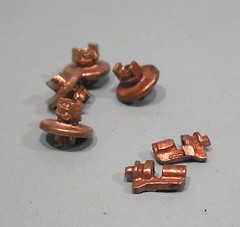Most of the Garratt Locomotive detail is, as is usual for model loco kits, cast in whitmetal. However this material is too soft for some of the working parts, especially surfaces which will see a lot of wear. Ironically on real engines, whitemetal bears were quite common but of course these were lubricated and replaced as required.
For the slide bars and cylinders you need something harder and in this case that means brass. The castings are made using a lost wax process and arrive on sprues like any other. Cutting them free requires big cutters or piercing saw. I then had to remove a chunk from the stub at the back of the cylinder face before drilling out the centre for the rod.
The front castings are for the valve guides and these are more of a problem. They too have to be drilled out but in this case there are two tubes that have to be tweaked to be in line and then put on the drill. Quite a bit of accuracy is required here and I'm struggling a little bit. I think the solution is to drill each part separately and then line them up rather than the other way around.
Update: That idea doesn't work. Instead I drilled through in one hit from the front using a 1.3mm bit which allows more than enough leaway for the valve spindle. Where the hole wasn't accurate enough in the cylinder wall, a broach could be slipped through fronm the buffer beam end to open the hole out a bit.

No comments:
Post a Comment